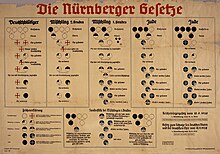Mischling was a pejorative legal term which was used in Nazi Germany to denote persons of mixed "Aryan" and non-Aryan, such as Jewish, ancestry as they were classified by the Nuremberg racial laws of 1935. In German, the word has the general denotation of hybrid, mongrel, or half-breed. Outside its use in official Nazi terminology, the term Mischlingskinder was later used to refer to war babies born to non-white soldiers and German mothers in the aftermath of World War II.
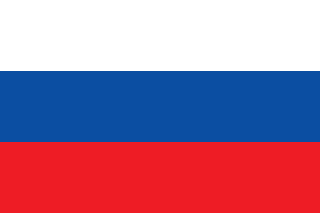
The (First) Slovak Republic, otherwise known as the Slovak State, was a partially-recognized client state of Nazi Germany which existed between 14 March 1939 and 4 April 1945 after abandoning Czechoslovakia to be annexed by Germany. The Slovak part of Czechoslovakia declared independence with German support one day before the German occupation of Bohemia and Moravia. The Slovak Republic controlled the majority of the territory of present-day Slovakia but without its current southern parts, which were ceded by Czechoslovakia to Hungary in 1938. It was the first time in history that Slovakia had been a formally independent state.

The Nuremberg Laws were antisemitic and racist laws that were enacted in Nazi Germany on 15 September 1935, at a special meeting of the Reichstag convened during the annual Nuremberg Rally of the Nazi Party. The two laws were the Law for the Protection of German Blood and German Honour, which forbade marriages and extramarital intercourse between Jews and Germans and the employment of German females under 45 in Jewish households; and the Reich Citizenship Law, which declared that only those of German or related blood were eligible to be Reich citizens. The remainder were classed as state subjects without any citizenship rights. A supplementary decree outlining the definition of who was Jewish was passed on 14 November, and the Reich Citizenship Law officially came into force on that date. The laws were expanded on 26 November 1935 to include Romani and Black people. This supplementary decree defined Romanis as "enemies of the race-based state", the same category as Jews.
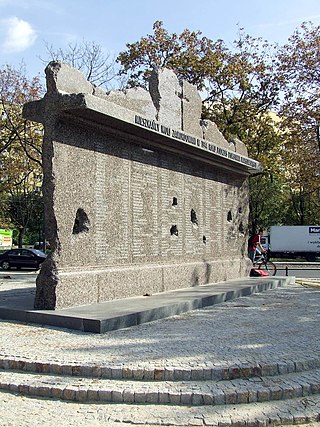
Crimes against the Polish nation committed by Nazi Germany and Axis collaborationist forces during the invasion of Poland, along with auxiliary battalions during the subsequent occupation of Poland in World War II, included the genocide of millions of Polish people, especially the systematic extermination of Jewish Poles. These mass killings were enacted by the Nazis with further plans that were justified by their racial theories, which regarded Poles and other Slavs, and especially Jews, as racially inferior Untermenschen.

The Law for Protection of the Nation was a Bulgarian law, effective from 23 January 1941 to 27 November 1944, which directed measures against Jews and others whose legal definition it established. The law was an anti-Jewish racial law passed by the parliament of the Kingdom of Bulgaria in December 1940 along the example of the Nuremberg Laws in Nazi Germany. Under it, Jews were to be refused Bulgarian citizenship, in addition to:
Responsibility for the Holocaust is the subject of an ongoing historical debate that has spanned several decades. The debate about the origins of the Holocaust is known as functionalism versus intentionalism. Intentionalists such as Lucy Dawidowicz argue that Adolf Hitler planned the extermination of the Jewish people as early as 1918, and personally oversaw its execution. However, functionalists such as Raul Hilberg argue that the extermination plans evolved in stages, as a result of initiatives that were taken by bureaucrats in response to other policy failures. To a large degree, the debate has been settled by acknowledgement of both centralized planning and decentralized attitudes and choices.
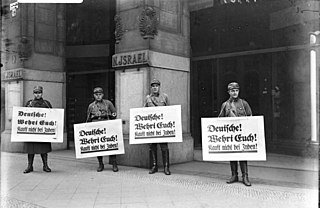
The Nazi boycott of Jewish businesses in Germany began on April 1, 1933, and was claimed to be a defensive reaction to the anti-Nazi boycott, which had been initiated in March 1933. It was largely unsuccessful, as the German population continued to use Jewish businesses, but revealed the intent of the Nazis to undermine the viability of Jews in Germany.

Anti-Jewish legislation in pre-war Nazi Germany comprised several laws that segregated the Jews from German society and restricted Jewish people's political, legal and civil rights. Major legislative initiatives included a series of restrictive laws passed in 1933, the Nuremberg Laws of 1935, and a final wave of legislation preceding Germany's entry into World War II.
The Reich Association of Jews in Germany, also called the new one for clear differentiation, was a Jewish umbrella organisation formed in Nazi Germany in February 1939. The Association branched out from the Reich Representation of German Jews established in September 1933. The new Association was an administrative body concerned predominantly with the coordination and support of the emigration and forcible deportation of Jewish people, subject to the Reich government's ever-changing legislation enforced by the RSHA (Reichssicherheitshauptamt). The legal status of the new organisation was changed on 4 July 1939 on the basis of the Nuremberg Laws, and defined by the 10th Regulation to the Citizenship Law issued by the Reich's ministry of the Interior. The Association assumed the so-called oldReichsvereinigung der Juden in Deutschland, which was the name under which the Reichsvertretung der Deutschen Juden had been operating since February 1939.
The conversion of Jews to Catholicism during the Holocaust is one of the most controversial aspects of the record of Pope Pius XII during The Holocaust.

The Eternal Jew was the title of an exhibition of antisemitism displayed at the Library of the German Museum in Munich from 8 November 1937 to 31 January 1938. The displays, with photographs and caricatures, focused on antisemitic canards falsely accusing Jews of Bolshevising Nazi Germany. It was best exemplified in the exhibition poster presenting an 'eastern' Jew wearing a kaftan and holding gold coins in one hand and a whip in the other. The exhibition attracted 412,300 visitors, over 5,000 per day.
Racism in Poland in the 20th and 21st centuries has been a subject of extensive study. Ethnic minorities made up a greater proportion of the country's population from the founding of the Polish state through the Second Polish Republic than in the 21st century, when government statistics show 94% or more of the population self-reporting as ethnically Polish.
Anti-Jewish boycotts are organized boycotts directed against Jewish people to exclude them economical, political or cultural life. Antisemitic boycotts are often regarded as a manifestation of popular antisemitism.
Bernhard Lösener was a lawyer and Jewish expert in the Reich Ministry of the Interior. He was among the lawyers who helped draft the Nuremberg Laws, among other legislation that deprived German Jews of their rights and ultimately led to their deportation to concentration camps.
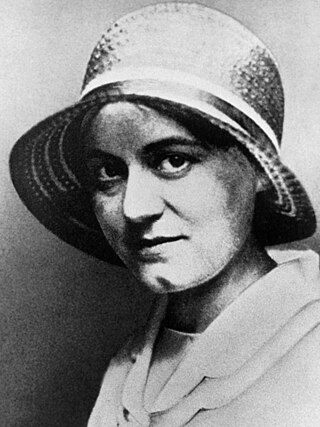
Several Catholic countries and populations fell under Nazi domination during the period of the Second World War (1939–1945), and ordinary Catholics fought on both sides of the conflict. Despite efforts to protect its rights within Germany under a 1933 Reichskonkordat treaty, the Church in Germany had faced persecution in the years since Adolf Hitler had seized power, and Pope Pius XI accused the Nazi government of sowing 'fundamental hostility to Christ and his Church'. The concordat has been described by some as giving moral legitimacy to the Nazi regime soon after Hitler had acquired quasi-dictatorial powers through the Enabling Act of 1933, an Act itself facilitated through the support of the Catholic Centre Party. Pius XII became Pope on the eve of war and lobbied world leaders to prevent the outbreak of conflict. His first encyclical, Summi Pontificatus, called the invasion of Poland an "hour of darkness". He affirmed the policy of Vatican neutrality, but maintained links to the German Resistance. Despite being the only world leader to publicly and specifically denounce Nazi crimes against Jews in his 1942 Christmas Address, controversy surrounding his apparent reluctance to speak frequently and in even more explicit terms about Nazi crimes continues. He used diplomacy to aid war victims, lobbied for peace, shared intelligence with the Allies, and employed Vatican Radio and other media to speak out against atrocities like race murders. In Mystici corporis Christi (1943) he denounced the murder of the handicapped. A denunciation from German bishops of the murder of the "innocent and defenceless", including "people of a foreign race or descent", followed.
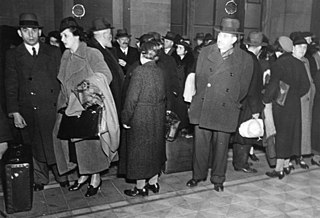
In October 1938, about 17,000 Polish Jews living in Nazi Germany were arrested and expelled. These deportations, termed by the Nazis Polenaktion, were ordered by SS officer and head of the Gestapo Reinhard Heydrich. The deported Jews were initially rejected by Poland and therefore had to live in makeshift encampments along the Germany–Poland border.

The Holocaust in Slovakia was the systematic dispossession, deportation, and murder of Jews in the Slovak State, a client state of Nazi Germany, during World War II. Out of 89,000 Jews in the country in 1940, an estimated 69,000 were murdered in the Holocaust.

Presidential exemptions were granted by President of the Slovak State Jozef Tiso to individual Jews, exempting them from systematic persecution through anti-Jewish legislation introduced by Tiso's Jewish Code,, during the Holocaust. The exemptions were exchanged for arbitrary monetary fees. From an estimated 20,000 requests, 600 documented exemptions covering 1,000 people were granted, but only after 1942, when deportations to Auschwitz death camp had already stopped. Following the German invasion of 1944, when deportations resumed, all exemptions were nullified.

The Holocaust in Bohemia and Moravia resulted in the deportation, dispossession, and murder of most of the pre-World War II population of Jews in the Czech lands that were annexed by Nazi Germany between 1939 and 1945.

The Holocaust in Germany was the systematic persecution, deportation, imprisonment, and murder of Jews in Germany as part of the Europe-wide Holocaust perpetrated by Nazi Germany. The term typically refers only to the areas that were part of Germany prior to the Nazi regime coming to power and excludes some or all of the territories annexed by Nazi Germany, such as Austria or the Protectorate of Bohemia and Moravia.
